JavaScript is disabled for your browser. Some features of this site may not work without it.
Buscar en RiuNet
Listar
Mi cuenta
Estadísticas
Ayuda RiuNet
Admin. UPV
An integrative "omics" apprach identifies new candidate genes to impact aroma volatiles in peach fruit
Mostrar el registro sencillo del ítem
Ficheros en el ítem
| dc.contributor.author | Sánchez, Gerardo
|
es_ES |
| dc.contributor.author | Venegas Calerón, Monica
|
es_ES |
| dc.contributor.author | Salas, J
|
es_ES |
| dc.contributor.author | Monforte Gilabert, Antonio José
|
es_ES |
| dc.contributor.author | Badenes, M.L.
|
es_ES |
| dc.contributor.author | Granell Richart, Antonio
|
es_ES |
| dc.date.accessioned | 2016-05-12T11:01:17Z | |
| dc.date.available | 2016-05-12T11:01:17Z | |
| dc.date.issued | 2013-05-23 | |
| dc.identifier.issn | 1471-2164 | |
| dc.identifier.uri | http://hdl.handle.net/10251/63968 | |
| dc.description.abstract | [EN] Background: Ever since the recent completion of the peach genome, the focus of genetic research in this area has turned to the identification of genes related to important traits, such as fruit aroma volatiles. Of the over 100 volatile compounds described in peach, lactones most likely have the strongest effect on fruit aroma, while esters, terpenoids, and aldehydes have minor, yet significant effects. The identification of key genes underlying the production of aroma compounds is of interest for any fruit-quality improvement strategy. Results: Volatile (52 compounds) and gene expression (4348 genes) levels were profiled in peach fruit from a maturity time-course series belonging to two peach genotypes that showed considerable differences in maturation characteristics and postharvest ripening. This data set was analyzed by complementary correlation-based approaches to discover the genes related to the main aroma-contributing compounds: lactones, esters, and phenolic volatiles, among others. As a case study, one of the candidate genes was cloned and expressed in yeast to show specificity as an omega-6 Oleate desaturase, which may be involved in the production of a precursor of lactones/esters. Conclusions: Our approach revealed a set of genes (an alcohol acyl transferase, fatty acid desaturases, transcription factors, protein kinases, cytochromes, etc.) that are highly associated with peach fruit volatiles, and which could prove useful in breeding or for biotechnological purposes. | es_ES |
| dc.description.sponsorship | We are grateful to Cristina Besada, PhD (Instituto Valenciano de Investigaciones Agrarias, IVIA, Spain) for her help with the fruit quality parameter analyses. We are also thankful to Cristina Marti and Clara Pons (Instituto de Biologia Molecular y Celular de Plantas, IBMCP, Spain) for their advice on microarray analyses. Jesus Garcia Brunton, PhD for providing the fruits used in this study (Instituto Murciano de Investigacion y Desarrollo Agrario, IMIDA, Spain). HS-SPME-GC-MS analyses were performed at the Metabolomic lab facilities at the IBMCP (CSIC) in Spain. GS has financial support from INTA (Instituto Nacional de Tecnologia Agropecuaria, Argentine). This project has been funded by the Ministry of Economy and Competitivity grant AGL2010-20595. | |
| dc.language | Inglés | es_ES |
| dc.publisher | BioMed Central | es_ES |
| dc.relation.ispartof | BMC Genomics | es_ES |
| dc.rights | Reconocimiento (by) | es_ES |
| dc.title | An integrative "omics" apprach identifies new candidate genes to impact aroma volatiles in peach fruit | es_ES |
| dc.type | Artículo | es_ES |
| dc.identifier.doi | 10.1186/1471-2164-14-343 | |
| dc.relation.projectID | info:eu-repo/grantAgreement/MICINN//AGL2010-20595/ES/PROGRAMAS DE MEJORA DEL ALBARICOQUERO Y MELOCOTONERO PARA LA OBTENCION Y SELECCION DE NUEVAS VARIEDADES DE ALTA CALIDAD. DESARROLLO DE HERRAMIENTAS GENETICAS Y GENOMICAS/ | es_ES |
| dc.rights.accessRights | Abierto | es_ES |
| dc.contributor.affiliation | Universitat Politècnica de València. Instituto Universitario Mixto de Biología Molecular y Celular de Plantas - Institut Universitari Mixt de Biologia Molecular i Cel·lular de Plantes | es_ES |
| dc.description.bibliographicCitation | Sánchez, G.; Venegas Calerón, M.; Salas, J.; Monforte Gilabert, AJ.; Badenes, M.; Granell Richart, A. (2013). An integrative "omics" apprach identifies new candidate genes to impact aroma volatiles in peach fruit. BMC Genomics. 14(343):1-23. https://doi.org/10.1186/1471-2164-14-343 | es_ES |
| dc.description.accrualMethod | S | es_ES |
| dc.relation.publisherversion | http://dx.doi.org/10.1186/1471-2164-14-343 | es_ES |
| dc.description.upvformatpinicio | 1 | es_ES |
| dc.description.upvformatpfin | 23 | es_ES |
| dc.type.version | info:eu-repo/semantics/publishedVersion | es_ES |
| dc.description.volume | 14 | es_ES |
| dc.description.issue | 343 | es_ES |
| dc.relation.senia | 256772 | es_ES |
| dc.identifier.pmid | 23701715 | en_EN |
| dc.identifier.pmcid | PMC3685534 | en_EN |
| dc.contributor.funder | Ministerio de Ciencia e Innovación |








